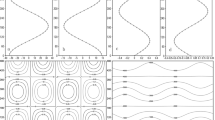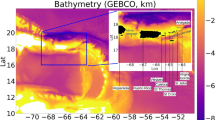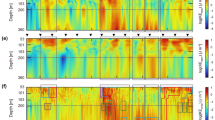Abstract
The upper ocean has complex and variable temperature stratification, and the surface layers in the northwest Bay of Bengal in winter indicate the presence of transient thermal inversions that wane with the advancement of the season. During winter, the sea surface loses heat and the surface waters of the coastal regions of the east coast of India are fairly stratified with the residual freshwater atop from the preceding southwest monsoonal discharge. The vertical stability favors the formation and sustenance of temperature inversions. To investigate the mechanism and the influence of ubiquitous internal waves that thrive on stability, a three-dimensional Princeton Ocean Model is configured for the east coast of India and is applied to study the process in the surface layers in association with the internal waves. The model domain constitutes a variable curvilinear grid, and the input fields comprise bathymetry, initial temperature and salinity, wind stress, air-sea heat fluxes and tidal forcing at the open boundaries. The numerical experiments demonstrate that vertical stability alone cannot cause, support or augment the internal wave oscillations, if the stratification is attributed to salinity only. Internal waves may therefore be perceived in stable layers, essentially from temperature-induced stratification. Despite stratification and enough vertical density gradient in the upper ocean, the conditions may not suit for the occurrence of internal waves due to thermal diffusive processes that overpower the salinity gradients. The vertical spreading of heat due to double diffusion is believed to be transparent to tidal forcing as the generation of internal waves is subdued even under density stratification. The model simulations indicate that the horizontal convergence/divergence motions, required for the manifestation of internal waves at the surface are inhibited in the presence of temperature inversion. The available SAR imageries in winter endorse the model simulations to this effect.








Similar content being viewed by others
References
Babu SV, Rao AD, Mahapatra DK (2008) Pre-monsoon variability of ocean processes along the east coast of India. J Coastal Res 24(3):628–639. doi:10.2112/06-0744.1
Blumberg AF, Mellor GL (1987) A description of a three dimensional coastal ocean circulation model. In: Heaps NS (ed) Three-dimensional coastal ocean models. Coastal estuarine ser, vol 4. AGU, Washington, D.C, pp 1–16
Boyer T, Levitus S, Garcia H, Locarnini R, Stephens C, Antonov J (2004) Objective analyses of annual, seasonal, and monthly temperature and salinity for the World Ocean on a 1/4_ grid. Int J Clim 25:931–945
Ezer T, Mellor GL (1994) Diagnostic and prognostic calculations of the North Atlantic circulation and sea level using a sigma coordinate ocean model. J Geophys Res 99(C7):14,159–14171
Gopal Krishna VV, Sastry JS (1985) Surface circulation over the shelf off the east-coast of India during the southwest monsoon. Indian J Mar Sci 14(1985):62–65
Han W, McCreary JP (2001) Modeling salinity distributions in the Indian Ocean. J Geophys Res 106:859–877
Haney RL (1991) On the pressure gradient force over steep topography in sigma coordinate ocean models. J Phys Oceanogr 21:610–619
Howden SD, Murtugude R (2001) Effects of river inputs into the Bay of Bengal. J Geophys Res 106(C9):19,825–19843
Jensen TG (2001) Arabian Sea and Bay of Bengal exchange of salt and tracers in an ocean model. Geophys Res Lett 28:3967–3970
Jensen TG (2003) Cross-equatorial pathways of salt and tracers from the northern Indian Ocean: modelling results. Deep Sea Res II 50:2111–2127
Johns B, Rao AD, Rao GS (1992) On the occurrence of upwelling along the east coast of India. Estuar Coast Shelf Sci 35:75–90
Mellor GL (1992) User’s guide for a three-dimensional, primitive equation, numerical ocean model. report, 35 pp., Program in Atmos. and Oceanic Sci. Princeton Univ, Princeton, N. J
Mellor GL, Yamada T (1982) Development of a turbulence closure model for geophysical fluid problems. Rev Geophys 20:851–875
Murtugudde R, Busalacchi AJ (1999) Interannual variability of the dynamics and thermodynamics of the tropical Indian Ocean. J Climate 12:2300–2326
Panakala Rao D, Sastry JS (1981) Circulation and distribution of some hydrographical properties during the late winter in the Bay of Bengal Mahasagar. Bull Natl Inst Oceanogr 14:1–15
Prabhakara Rao B, Babu Ramesh and Mohan Chandra (1987) Seasonal and diurnal variability of thermal structure in the coastal waters off Visakapattnam. Proceedings of the Indian Academy of Sciences (Earth and Planetary Sciences) 96:69–79
Rao RR, Rao DS, Murthy PGK, Joseph MX (1983) A preliminary investigation of the summer monsoonal forcing on the thermal structure of upper Bay of Bengal during Monex-79. Mausum 32:85–92
Rao SA, Gopalakrishna VV, Sheyte SR and Yamagata T (2002) Why were cool SST anomalies absent in the Bay of Bengal during the 1997 Indian Ocean Dipole Event? Geophysical Research Letters 29(11)
Rao AD, Madhu J, Babu SV (2005) A three-dimensional numerical model of coastal upwelling along the west coast of India. Math Comput Model 41(1–2):177–195
Rao AD, Babu SV, Prasad KVSR, Ramana Murty TV, Sadhuram Y, Mahapatra DK (2010) Investigation of the generation and propagation of low frequency internal waves: a case study for the east coast of India. Estuar Coast Shelf Sci 88:143–152
Shenoi SSC, Shankar D and Shetye S (2002) Differences in heat budgets of the near-surface Arabian Sea and Bay of Bengal: implications for the summer monsoon, J Geophys Res. 107, doi: 10.1029/2000JC000679
Shetye SR, Shenoi SSC, Gouveia AD, Michael GS, Sundar D, Nampoothiri G (1991) Wind-driven coastal upwelling along the western boundary of the Bay of Bengal during the southwest monsoon. Continental Shelf Res 11:1397–1408
Shetye SR, Gouveia AD, Shankar D, Shenoi SSC, Vinayachandran PN, Sundar D, Michael GS, Nampoothiri G (1996) Hydrography and circulation in the western Bay of Bengal during the Northeast Monsoon. J Geophys Res 101:14,011–14025
Sindhu I, Suresh I, Unnikrishnan AS, Bhatkar NV, Neetu S, Michael GS (2007) Improved bathymetric data sets for the shallow water regions in the Indian Ocean. J Earth Syst Sci 116(3):261–274
Suryanarayana A, Murty VSN, Rao DP (1993) Hydrography, circulation of the Bay of Bengal during early winter. Deep-Sea Res I 40(1):205–217
Thompson B, Gnanaseelan C, Salvekar PS (2006) Seasonal evolution of temperature inversions in the north Indian Ocean. Curr Sci 90(5):697–704
Acknowledgments
We sincerely thank the Naval Research Board (India) for providing the financial support during the course of the study. Thanks are also due to Dr D Srinivasan, former director of NPOL for his useful comments and suggestions in bringing out this article.
Author information
Authors and Affiliations
Corresponding author
Rights and permissions
About this article
Cite this article
Babu, S.V., Rao, A.D. Mixing in the surface layers in association with internal waves during winter in the northwestern Bay of Bengal. Nat Hazards 57, 551–562 (2011). https://doi.org/10.1007/s11069-010-9607-5
Received:
Accepted:
Published:
Issue Date:
DOI: https://doi.org/10.1007/s11069-010-9607-5




